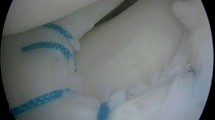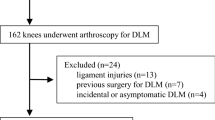Abstract
Objective
In young patients, the discoid lateral meniscus (DLM) usually becomes symptomatic at the time of peripheral rim instability of a complete discoid form. However, little is known about the natural history of meniscal instability. The aim was to detect hidden forms of presentation of instability using the history and clinical mechanical symptoms of instability.
Methods
Retrospective study of 114 paediatric knees treated for DLM. A new clinical grading system for instability (stable, locked, snapping, blocked and unblocked knees) was defined and studied in combination with MRI and arthroscopic findings.
Results
One hundred seven DLMs (94%) showed instability due to edge detachment. Fifteen (13%) knees were stable (grade 0), 2 (2%) were grade 1, 57 (50%) were grade 2, 35 (31%) were grade 3 and 5 (4%) were grade 4. The cause of grade 3 was an extension deficit (26/35) or flexion deficit (9/35). Grade 1 or 2 correlated with limited detachment, unlike grade 3 or 4. The grade of instability never decreased, but rather increased in many knees during the natural history of DLM.
Conclusion
A new presentation of DLM is presented: episodic locking phenomenon and blocked knee with flexion deficit. Clinicians should be wary of pseudo-improvement with the recovery of mobility after a period of the blocked knee, which may be due to a progression towards the ultimate degree of instability. Clinical grading of instability has clarified the natural history of DLM-associated tearing.
Level of evidence
III.




Similar content being viewed by others
Data availability
Data are availlable.
Change history
01 September 2023
In Abstract under Conclusion, the word locked knee changed to blocked knee.
References
Dickhaut SC, DeLee JC (1982) The discoid lateral-meniscus syndrome. J Bone Joint Surg Am 64(7):1068–1073
Ikeuchi H (1982) Arthroscopic treatment of the discoid lateral meniscus. Technique and long-term results. Clin Orthop Relat Res 167:19–28
Ahn JH, Lee YS, Ha HC, Shim JS, Lim KS (2009) A novel magnetic resonance imaging classification of discoid lateral meniscus based on peripheral attachment. Am J Sports Med. 37(8):1564–1569
Watanabe M, Takeda S, Ikeuchi H (1979) Atlas of arthroscopy, 3rd edn. Igaku-Shoin, Tokyo, pp 75–130
Papadopoulos A, Kirkos JM, Kapetanos GA (2009) Histomorphologic study of discoid meniscus. Arthroscopy. 25(3):262–268
Tudisco C, Botti F, Bisicchia S (2021) Histological study of discoid lateral meniscus in children and adolescents: morphogenetic considerations. Joints 7(4):155–158
Bellier G, Dupont JY, Larrain M, Caudron C, Carlioz H (1989) Lateral discoid menisci in children. Arthroscopy 5(1):52–56
Patel NM, Cody SR, Ganley TJ (2012) Symptomatic bilateral discoid menisci in children: a comparison with unilaterally symptomatic patients. J Pediatr Orthop 32(1):5–8
Bin SI, Kim JC, Kim JM, Park SS, Han YK (2002) Correlation between type of discoid lateral menisci and tear pattern. Knee Surg Sports Traumatol Arthrosc 10(4):218–222
Chen G, Zhang Z, Li J (2016) Symptomatic discoid lateral meniscus: a clinical and arthroscopic study in a Chinese population. BMC Musculoskelet Disord 17:329. https://doi.org/10.1186/s12891-016-1188-3
Hayashi LK, Yamaga H, Ida K, Miura T (1988) Arthroscopic meniscectomy for discoid lateral meniscus in children. J Bone Joint Surg Am 70(10):1495–1500
Jung JY, Choi SH, Ahn JH, Lee SA (2013) MRI findings with arthroscopic correlation for tear of discoid lateral meniscus: comparison between children and adults. Acta Radiol 54(4):442–447
Klingele KE, Kocher MS, Hresko MT, Gerbino P, Micheli LJ (2004) Discoid lateral meniscus: prevalence of peripheral rim instability. J Pediatr Orthop 24(1):79–82
Kocher MS, Logan CA, Kramer DE (2017) Discoid lateral meniscus in children: diagnosis, management, and outcomes. J Am Acad Orthop Surg 25(11):736–743
Kang MS, Kim JM, Park SS, Bin SI (2019) Prediction of the peripheral rim instability of the discoid lateral meniscus in children by using preoperative clinicoradiological factors. J Pediatr Orthop. 39(10):e761–e768
Ahn JH, Shim JS, Hwang CH, Oh WH (2001) Discoid lateral meniscus in children: clinical manifestations and morphology. J Pediatr Orthop. 21(6):812–816
Yoo WJ, Choi IH, Chung CY, Lee MC, Cho TJ, Park MS, Lee DY (2008) Discoid lateral meniscus in children: limited knee extension and meniscal instability in the posterior segment. J Pediatr Orthop. 28(5):544–548
Ahn JH, Lee SH, Yoo JC, Lee YS, Ha HC (2008) Arthroscopic partial meniscectomy with repair of the peripheral tear for symptomatic discoid lateral meniscus in children: results of minimum 2 years of follow-up. Arthroscopy 24(8):888–898
Hancock GE, Hepworth T, Wembridge K (2018) Accuracy and reliability of knee goniometry methods. J Exp Orthop 5(1):46
Jones A, Sealey R, Crowe M, Gordon S (2014) Concurrent validity and reliability of the simple goniometer iPhone app compared with the universal goniometer. Physiother Theory Pract 30(7):512–516
George M, Wall EJ (2003) Locked knee caused by meniscal subluxation: magnetic resonance imaging and arthroscopic verification. Arthroscopy 19(8):885–888
Li Z, Fan W, Dai Z et al (2021) Widening of the popliteal hiatus on sagittal MRI view plays a critical role in the mechanical signs of discoid lateral meniscus. Knee Surg Sports Traumatol Arthrosc 29(9):2843–2850
Gans I, Bedoya MA, Ho-Fung V, Ganley TJ (2015) Diagnostic performance of magnetic resonance imaging and pre-surgical evaluation in the assessment of traumatic intra-articular knee disorders in children and adolescents: what conditions still pose diagnostic challenges? Pediatr Radiol 45(2):194–202
Hashimoto Y, Kazuya N, Takigami J et al (2020) Abnormal displacement of discoid lateral meniscus with snapping knee detected by full extension and deep flexion MRI: Report of two cases. Asia Pac J Sports Med Arthrosc Rehabil Technol 21:1–4. https://doi.org/10.1016/j.asmart.2020.03.004
Yang SJ, Zhang MZ, Li J, Xue Y, Chen G (2021) A reliable, ultrasound-based method for the diagnosis of discoid lateral meniscus. Arthroscopy 37(3):882–890
Good CR, Green DW, Griffith MH, Valen AW, Widmann RF, Rodeo SA (2007) Arthroscopic treatment of symptomatic discoid meniscus in children: classification, technique, and results. Arthroscopy 23(2):157–163
Lau BC, Vashon T, Janghala A, Pandya NK (2018) The sensitivity and specificity of preoperative history, physical examination, and magnetic resonance imaging to predict articular cartilage injuries in symptomatic discoid lateral meniscus. J Pediatr Orthop. 38(9):e501–e506
Adachi N, Ochi M, Uchio Y, Kuriwaka M, Shinomiya R (2004) Torn discoid lateral meniscus treated using partial central meniscectomy and suture of the peripheral tear. Arthroscopy. 20(5):536–542
Logan CA, Tepolt FA, Kocher SD, Feroe AG, Micheli LJ, Kocher MS (2021) Symptomatic discoid meniscus in children and adolescents: a review of 470 cases. J Pediatr Orthop 41(8):496–501
Acknowledgements
Camille Vandergugten, Véréna Landel from the Department of Publication of the Hospices Civils de Lyon, for their help in manuscript preparation, Julien Berthiller and Dr Parot for help in statistical analysis and thanks to Pr Romain Seil and Dr Radj Pem for English corrections.
Funding
No funding.
Author information
Authors and Affiliations
Contributions
Contribution to data analysis and writing manuscripts for VS and BPH. Analysis and interpretation of data for others authors. BH for her significant participation in the editing of the manuscript. Contributions to conception and design and analysis and interpretation of data for FC.
Corresponding author
Ethics declarations
Conflict of interest
No conflict of interest for any author and co-authors.
Ethical approval
The study protocol was approved by Lyon university hospital for Mothers and Children, and Claude Bernard University Lyon I research ethics board (N°20_069).
Informed consent
Retrospective study.
Additional information
Publisher's Note
Springer Nature remains neutral with regard to jurisdictional claims in published maps and institutional affiliations.
Supplementary Information
Below is the link to the electronic supplementary material.
Rights and permissions
Springer Nature or its licensor (e.g. a society or other partner) holds exclusive rights to this article under a publishing agreement with the author(s) or other rightsholder(s); author self-archiving of the accepted manuscript version of this article is solely governed by the terms of such publishing agreement and applicable law.
About this article
Cite this article
Simon, V., Paul Henri, B., Charles, F. et al. Discoid lateral meniscus instability in children: part I. A new grading system of instability to clarify natural history. Knee Surg Sports Traumatol Arthrosc 31, 4809–4815 (2023). https://doi.org/10.1007/s00167-023-07521-w
Received:
Accepted:
Published:
Issue Date:
DOI: https://doi.org/10.1007/s00167-023-07521-w




